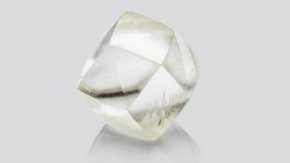De Beers announced several developments at its JCK Las Vegas breakfast event, most notably that it would stop producing lab-grown diamonds for its Lightbox jewelry brand. It also unveiled a wider strategy, Origins, that focuses on marketing natural diamonds and capitalizing on De Beers’ ability to sell diamonds with clear provenance.
Rapaport News sat down with De Beers CEO Al Cook on the day of those announcements, May 31. In this interview, he clarified aspects of the lab-grown strategy, explained how De Beers would be manufacturing natural rough diamonds via contractors, and commented on the impending separation from parent company Anglo American. The interview has been edited for length and clarity.
Of all the points that came up in the new De Beers strategy, which would you say was the most important?
The focus on value. We will increase the value of De Beers for our partners, for our stakeholders, and for our shareholders.
One of the things that caught my attention was the update about lab-grown diamonds. Element Six, De Beers’ synthetic-diamond unit, will no longer be producing lab-grown diamonds for jewelry. Does that include the Oregon plant?
Including the Oregon plant.
What’s going to happen with Lightbox?
Lightbox will continue as a brand. What we’ll do over the next few months is ensure that Lightbox has enough of an inventory to continue selling for the foreseeable future and meet all its contractual commitments. And then over time, as the Lightbox brand evolves, we’ll make decisions on that. I think Lightbox has a great brand. It’s out there with honest pricing, linear pricing, doing things that no one else did at the time that now look sensible. And the fact that we cut our prices by a further 30% or more really shows what Lightbox can do. Lightbox will continue to produce fun, fashionable jewelry, beautifully designed in the same way that it has.
How much inventory, in terms of time, does Lightbox have?
Enough for the foreseeable future. It’s not something I’m concerned about.
When will the production actually stop?
In a few months’ time.
After that, I guess there will be a few options. One would be Lightbox sourcing loose lab-grown stones from the market. Is that one of the options?
Lightbox for the foreseeable future will have all the inventory it needs to continue its business. Any decisions beyond that we will make at the right [time]. Core to the Lightbox proposition has been [that] we’re very proud that Lightbox is carbon-neutral[, and] we’re very proud it’s made in America. We intend to stick with that element of the brand.
Is one of the options that Lightbox will be discontinued eventually when this inventory has run out?
It’s not something we’re considering at the moment.
You mentioned this morning that you’re going to start manufacturing and selling polished.
Yes, we’re going to be looking at working with third-party contractors to cut and polish and to sell premium polished diamonds.
What proportion of De Beers rough will go toward that?
A minority. It’s too early to say. We have enormous respect for our sightholders and what they do. And the vast majority of our business is selling rough diamonds to our sightholders. We’ll be proudly continuing that and working with our sightholders through the course of 2025 to negotiate a new set of agreements, which will take us forward. In addition to that, we believe that De Beers is uniquely placed to sell premium polished diamonds. If you look at what we’ve got in terms of origin story, if you look at what we’ve got in terms of Tracr, if you look at what brands are asking us for, we believe we’re placed to do that, but it will be “and” not “or.”
When will that start?
The transition is underway. It’ll be through the course of this year.
Would these contractors include sightholders?
Absolutely.
Would they be entirely sightholders?
They would include sightholders.
Did sightholders know about this before today?
A number of them did. I think they fully understand, first of all, that the relationship with sightholders will continue for the next few decades as it has done. This is about an “and” rather than an “or.” It’s about a minority. It’s about an opportunity. As a business, we sit on $1.7 billion of rough inventory as of our last financial results. So we are very confident that we can meet every need [for] every one of our sightholders and do this on top.
To whom will the final polished be sold?
We’ve got a brand, Code of Origin, and that will be opened up to anyone who wants to buy a premium polished diamond from an ethical source with a guarantee that De Beers has held that diamond since it came out of the earth to the time that we hand over a beautiful polished diamond.
Would that be primarily retailers buying those diamonds from you, or would those be sold directly to consumers?
I think it’s too early to say. Of course, we already sell diamonds to consumers through De Beers Jewellers. So we would see De Beers Jewellers as one of the customers for that and what De Beers Jewellers would be able to do is…ensure that the diamonds that they sell have never left the hands of De Beers since they were sourced by De Beers.
How does this differ from previous De Beers origin programs?
I was here [in Las Vegas] a year ago. We were talking about Code of Origin and how we tell the story of that. Over the intervening time, we’ve ramped up the [number] of diamonds that we have on Tracr now to 70% [of De Beers’ production] by value. That means that 70% by value we can tell the individual story of. We have ramped up the digital solutions that we offer through Code of Origin. So it’s an evolution, not a change.
What is the objective behind the rarity score in your Origin Story program?
We have incredibly positive feedback on the early tests that we’ve done [showing] that the consumers obviously rely on the 4Cs, but the rarity score gives something that the 4Cs doesn’t — a real sense of how precious this diamond is. And at a time when you’ve got factory loads of Chinese ovens churning out lab-grown diamonds, it is completely distinct from that to provide a rarity score that demonstrates and underpins how unique a natural diamond is.
Another thing that caught my attention is that you will no longer be publishing the sight-by-sight results. When will that go into effect?
That will go into effect as of and after our first-half results [for 2024]. But I think we’ll continue what we’re doing until July. And then as we publish our results we’ll pivot towards quarterly. The feedback we’ve had from the industry and investors is what they would like is more transparency and less frequency.
How does that achieve more transparency?
We will be providing more information than we currently do on our sales performance at the end of every quarter.
So that would include volume data as well?
We’ll announce that in due course. But the aim here is to provide more, and more useful, data rather than less. So this is a step towards making De Beers more transparent. The exact data that we publish will go forward in due course. But when you see it you’ll go, “Oh my goodness, this is a lot more useful than what we used to get sight by sight.”
There’s been a lot of speculation about the possible sale of the business. How has that impacted the day-to-day operations of the company?
Not at all. Anglo American has said that De Beers and ourselves will go our separate ways. I think that’s been a growing part of the plan for a number of months. And whether it’s a de-merger or divestment, what remains very, very clear is that De Beers needs to continue doing what it’s done to create value. So for 124 of the 136-years history of De Beers, we haven’t had Anglo American as a majority owner. So it literally doesn’t affect one bit of our operations or one bit of our strategy.
Would a de-merger mean that the shareholders of Anglo American would remain the owners of the company?
There are a number of options for how you do a de-merger, but that’s certainly one of them.
How does the announcement that BHP won’t be pursuing acquisition talks with Anglo American impact that process?
I think it provides clarity that we will advance the plan that Anglo American announced a few weeks ago.
There has been some concern in the diamond trade about what the separation could mean, partly because De Beers has done an important job of maintaining stability during some of the recent downturns. Have there been concerns expressed to you that under different ownership that might change?
I think when people look at the history of De Beers, which existed for several decades before Anglo American was formed, they gained confidence that if, as you so generously say, people admire what De Beers did, the great majority of what it did was as an independent company. So I think people should have every confidence in De Beers in its new ownership structure. I think the future of diamonds lies as much in marketing and retail as it does in mining. So separating away from Anglo American, which is a mining company, enables us to really have strategic flexibility to deliver our full value.
On marketing, what do you think is the industry’s most pressing challenge?
I think it’s to feel the love. To recreate the desire for natural diamonds. I think we’re in an extraordinary point where there are more diamonds above the surface of the earth than below the surface of the earth. Every year, diamond mines are closing. We’ve got this extraordinary rare gem that only gets created once, takes a billion years to form, and we need to tell that story better. We need to allow people to express their desires to commemorate their most rare and unique and special moments of life with the most rare and unique and special of gemstones. And I think there are so many extraordinary stories with natural diamonds. And finally, through Tracr, we have the technology to tell those stories, the individual story of your diamond, what it’s done, where it came from, how it was formed, and the good that it’s done once it comes out of the ground. What we need to do is take the best of what we did in the second half of the 20th century but modernize it for a new audience that isn’t “white man gives engagement ring to white girl.” It’s the incredible diversity of relationships now, but still [reflects] the constant desire that humans have had for millions of years to commemorate the most important moments in their lives.
Does the industry have enough money to implement that marketing and to produce the advertising that’s needed?
Yes, it does. I’m very confident that would be the case.
It’s well known that, with the exit of Alrosa, the Natural Diamond Council (NDC) doesn’t have the money that it used to have. Has De Beers increased its contribution since then?
We see an important role for the Natural Diamond Council going forward. Their latest campaign is terrific. Seeing what they’re doing with Lily James in Canada is inspirational. And that partnership, that support will continue.
What is the potential of the cooperation with Signet Jewelers?
I’m really excited about that. We’ve got fantastic stories to tell. Signet has 20,000 customer representatives who can tell those stories, and we know that people choose what kind of diamond they buy when they come into a store the majority of the time. We have all the stories that come out of Botswana, Namibia, South Africa and Canada, and we compare that with the people who are best positioned in the world to tell that story to Americans, who want to mark the most important moment in their life.
Part of the story here is retailers no longer pushing lab-grown as a priority to customers. Is that the direction you see this going in?
Absolutely. And we see that as [being] in the retailers’ interests, because the margin they get from a lab-grown diamond is becoming pitifully small.
Image: Al Cook. (De Beers)
Stay up to date by signing up for our diamond and jewelry industry news and analysis.



